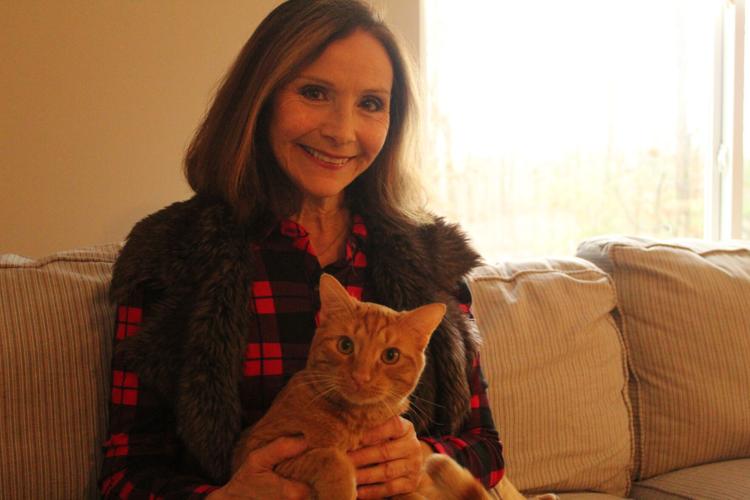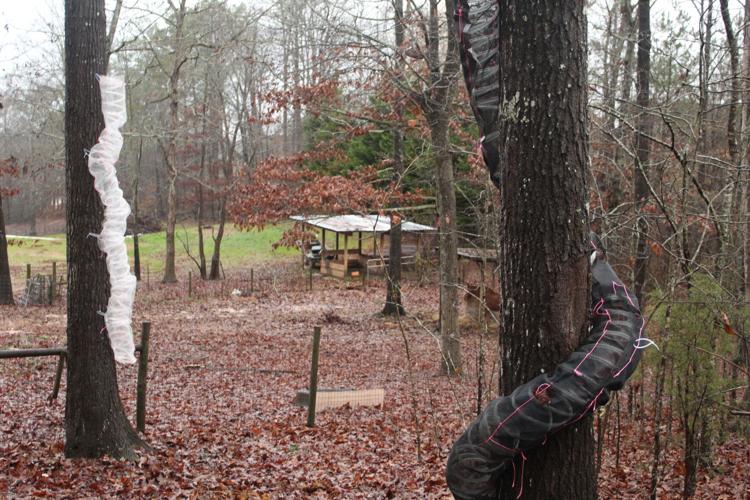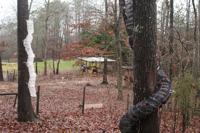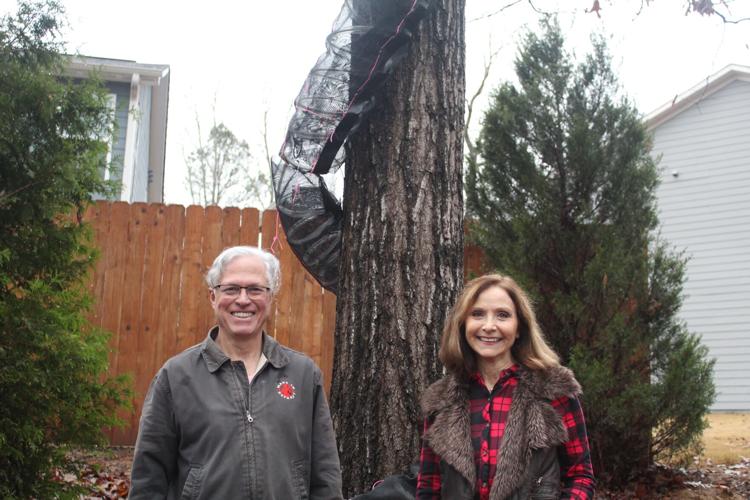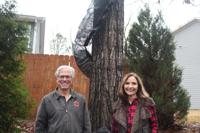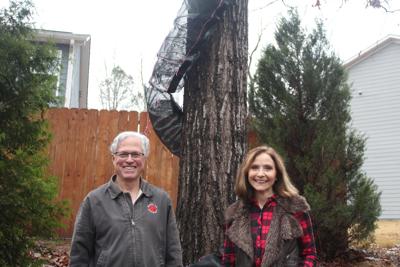CUMMING, Ga. — Little Guy, an orange Tabby cat, was stuck in a tree for seven days before being rescued.
On July 1, a “biblical thunderstorm” was underway with rain, lighting and wind that caused the branches to violently sway. It took Normer Adams, the 70-something-year-old operator of Cat Man Do Rescue, around five hours to retrieve Little Guy from the end of what looked like a vein-width’s limb 50-60 feet high with a pole.
The tree stands to the right of Michelle Lacobelle’s front porch, one house down, atop a ridge that overlooks her subdivision.
“I did tell God — I said, ‘If you take him, take me,” Lacobelle recalled, who at one point was hoisted up 30 feet herself.
Lacobelle said she lost 10 pounds in that week from stress.
“I would see little eyes and hear him meow every night,” she said.
But the taxing event sparked an idea for Lacobelle, a senior principal systems engineer in the defense and aerospace industry, leading her to produce a now-patented, cat rescue tunnel and apparatus, which she calls “Little Guy Cat Rescue.”
With the help of Mike Holihan, a longtime friend, former co-worker and serial inventor, Lacobelle received patent approval for the device Nov. 24. Both names are on the application, but Lacobelle is the first-named inventor.
Installation
Lacobelle and Holihan provided a demo of the invention Dec. 9. Similar to a cat tunnel that can be found at any pet store, Lacobelle’s creation is a long, plastic mesh tube about 10 inches in diameter with a coiled wire inside. The tunnel is flexible, lightweight and collapsible.

Mike Holihan, friend of Michelle Lacobelle, nails the cut tunnel in a “spiral configuration” using zip ties and staples Dec. 9. Holihan helped to write the patent application and is the second and last-named inventor of Lacobelle’s idea.
The cat tunnel itself can’t be patented, Lacobelle said, because someone let the tunnel claim go abandoned. Patent ideas can go somewhere like a boneyard composed of “prior art,” Holihan said.
“You still have to fight that even though it's been let go and no one claims it anymore,” Holihan said.
Every foot or so, Holihan cut a hole in the tunnel to allow for a zip tie, intended to be hammered to a tree using a staple — the patented method of installation to be fine-tuned in the manufacturing process. Zip ties aren’t necessary, Lacobelle said, but they allow a space for the staple to be used and secured to the tree.

There are two ways to configure the tunnel along a tree, an “S-shape configuration” and a “spiral configuration. On left, the S-shape configuration is installed on one side of the tree. The spiral configuration, on right, is installed by wrapping the tunnel around the tree.
Patent holders can have a “continuation pattern,” Holihan said, which allows a patent to be continuously modified. If a new application is filed within a year from the first, additions can be made, he said.
“There's other things that we've talked about that can be done with electronics,” Holihan said. “There are different things.”
One iteration of the tunnel, the “S-shaped configuration,” was already installed, nearly vertical but with kinks, running up one side of a tree by a horse pasture in a neighbor’s backyard. For demonstration, Lacobelle and Holihan created the second and last design, a “spiral configuration.”
Using a ladder, Holihan slowly wrapped and nailed the tunnel around the tree with Lacobelle assisting.
No guarantees
Holihan went up about 20 feet to attach the tunnel. But Lacobelle said if a cat were up higher, any tree climber could install the tunnel, walk away and let the cat come down. Lacobelle’s patent submission notes that multiple tunnels can be adjoined to fashion any length.
“A tree climber is not really a cat rescuer, and they'll charge you like $500 to rescue a cat with no guarantees,” Lacobelle said.
Before Adams showed up in July, Lacobelle tried calling the Forsyth County Fire Department. But the department said they couldn’t do anything — it was too risky. Forsyth County Division Chief Jason Shivers said the fire department gets these kinds of calls about once a month.
Half of the time, there’s not much they can do, Shivers said, so they usually suggest a local tree climber.
Lacobelle called the tree climber, but he couldn’t get Little Guy down after several attempts.
Using her immense cat knowledge, Lacobelle then began to think of the many ways to deliver Little Guy from his predicament, like constructing a hammock from netting and a 35-foot catwalk. But none of her efforts worked.
“The cat just wasn't coming down,” Lacobelle said. “It was like a suicide mission.”
Afterward, a neighbor helped Lacobelle find Adams, who had appeared on “The Ellen DeGeneres Show.” The day after Adams succeeded in his mission, Lacobelle began the process of what would become Little Guy Cat Rescue, writing the application alongside Holihan.
Patent approval
At the Dec. 9 demonstration, Lacobelle offered cinnamon coffee and a Danish. She flipped through the official patent approval, submitted Aug. 2 — only three weeks after Little Guy was rescued.
“It’s just a matter of time before they publish it fully on the website,” Lacobelle said.
Some of Lacobelle’s cats were lounging about in her bedroom upstairs and were hard for her to catch. But Little Guy had a calmer demeanor. Given the moniker “Bruce Lee” for his agility, Little Guy missed the birth of his litter while suspended. Most of his kittens, who Little Guy frequently cuddles, still reside with Lacobelle and have “Little” as their first name.
Lacobelle showed off a dedicated room for her cat, which had litter boxes, tunnels and a pink doll house.
“Of all the things I brought from California. I brought this,” said Lacobelle, who moved from Los Angeles a year and a half ago. “My daughter said, 'You don't need a playhouse.’ I said, ‘I do when I have kittens again.’”

Michelle Lacobelle holds Little Guy, her cat that inspired a new cat rescuing invention Dec. 9. Lacobelle created a method for installing a mesh cat tunnel to a tree, allowing tree-bound cats to crawl down. The tunnel is flexible, lightweight and collapsible.
Opposite the upstairs common space, Lacobelle’s vision board included plans for her invention as well as an easy, rich retirement.
“I want a million dollars,” Lacobelle said. “I want callbacks, interest, licensing, Petco…”
Lacobelle has been having conversations with Petco to market the product.
Now that her patent is approved, Lacobelle is a member of The Breakfast Club — a group of Holihan’s inventor colleagues from California, including Dave Crouch. Crouch, who has 50 patents and a PhD in physics, moved out east and met up with Lacobelle and Holihan for breakfast in northern Georgia.
“... One of the many blessings from rescuing Little Guy, who I love so much,” Lacobelle said.
